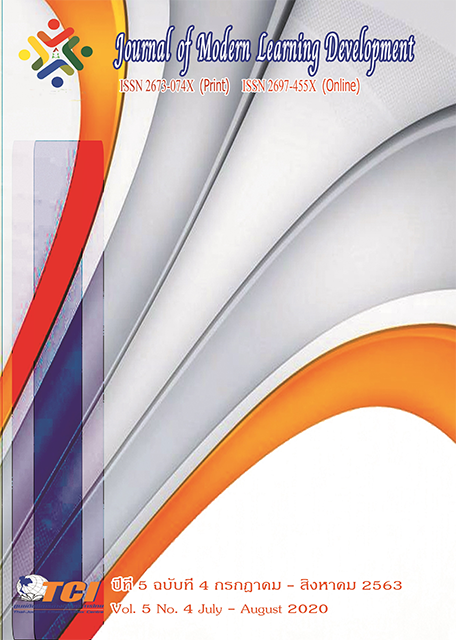Developing 4th Grade Students’ Creative Thinking and Learning Achievement in Changes and Environmental Conservation within the Province through the 6 - Hats Technique
Main Article Content
Abstract
The objectives of the present research study were 1) to develop 4th grade students’ creative thinking in changes and environmental conservation within the province through the 6-Hats Technique so that the students made a mean achievement score of 80% or better and at least 80% of the students passed the criterion and 2) to develop the students’ learning achievement on changes and environmental conservation within the province through the 6-Hats Technique so that the students made a mean learning achievement score of 80% or better and at least 80% of the students passed the criterion. The target group consisted of 30 grade-4 students in Ban Sai-ngarm Noen-pudin School, under Bueng-gan Primary Education Office, Kai Sub-district, Sopisai District, Bueng-gan Province, during the second semester of the 2019 academic year. The study employed the One-Group Posttest Only Design for the experiment. Three categories of research instrument were used in the study, i.e. 1) 5 social studies lesson plans on the topic of Changes and Environmental Conservation within the Province which took 10 instructional periods to finish, 2) a creative thinking test and 3) a learning achievement test. The collected data were analyzed by means of percentage, arithmetic mean and standard deviation.
The findings show that: 1) The students made a mean achievement score of 16.90 or 84.50% of the full marks on creative thinking on the topic of Changes and Environmental Conservation within the Province through the 6-Hats Technique (S.D. = 0.25), and 29 students or 96.67% of the group, passed the 80% criterion which is higher than the prescribe criterion.
2)The students made a mean learning achievement score of 26.60% or 88.67% of the full marks on the topic of Changes and Environmental Conservation within the Province (S.D. = 1.99), and 29 students or 96.67% of the group, passed the 80% criterion which is higher than the prescribe criterion.
Article Details
References
กระทรวงศึกษาธิการ. (2560). หลักสูตรแกนกลางการศึกษาขั้นพื้นฐาน พุทธศักราช 2551 (ฉบับปรับปรุง พ.ศ.2560). กรุงเทพมหานคร: โรงพิมพ์ชุมชนสหกรณ์การเกษตรแห่งประเทศไทย จำกัด.
เกรียงศักดิ์ เจริญวงศ์ศักดิ์. (2553). การคิดเชิงสร้างสรรค์. กรุงเทพมหานคร: ซักเซส มีเดีย.
นฤมล มีโสภา. (2550). การพัฒนาชุดฝึกทักษะการคิดแก้ปัญหาเรื่อง สรรพสิ่งในธรรมชาติ ด้วยเทคนิคหมวก 6 ใบ สำหรับนักเรียนชั้นประถมศึกษาปีที่ 4 . กรุงเทพมหานคร: มหาวิทยาลัยศิลปากร.
นารี เจนสาริกร. (2548). ผลการสอนโดยใช้กิจกรรมหมวกคิดหกใบ ของ เดอ โบโน ที่มีต่อผลสัมฤทธิ์ทางการเรียนวิชาสังคมศึกษา และความสามารถในการคิดอย่างมีวิจารณญาณ ของนักเรียนชั้นมัธยมศึกษาปีที่ 1. วิทยานิพนธ์หลักสูตรครุศาสตรมหาบัณฑิต สาขาวิชาหลักสูตรและการสอน. บัณฑิตวิทยาลัย:มหาวิทยาลัยราชภัฎนครสวรรค์.
ปริศนา ทะวันเวทย์. (2561). ผลการใช้ชุดกิจกรรมภาพการ์ตูนประกอบคำถามตามแนวคิดหมวก 6 ใบเพื่อพัฒนาการเขียนเชิงสร้างสรรค์สำหรับนักเรียนชั้นประถมศึกษาปีที่ 3. วิทยานิพนธ์ครุศาสตรมหาบัณฑิต สาขาวิชาหลักสูตรและการจัดการเรียนรู้. บัณฑิตวิทยาลัย: มหาวิทยาลัยราชภัฏบุรีรัมย์.
ปิยมาศ เตงชู. (2552). การพัฒนารูปแบบการจัดการเรียนรูโดยใชแนวคิดหมวกคิดหกใบ เพื่อพัฒนาการคิดอย่างมีวิจารณญาณ สำหรับนักเรียนชั้นมัธยมศึกษาปที่ 2. วิทยานิพนธการศึกษามหาบัณฑิต สาขาการวิจัยและประเมิน. บัณฑิตวิทยาลัย: มหาวิทยาลัยทักษิณ.
วิไลลักษณ์ สายเสน่ห์. (2556). ผลการสอนโดยใช้เทคนิควิธีการสอบแบบหมวกความคิดหกใบในวิชาการคิดเชิงวิจารณญาณและสร้างสรรค์ที่มีผลต่อความคิดสร้างสรรค์ของนักเรียนปริญญาบัณฑิต. กรุงเทพมหานคร: ทุนวิจัยอุดหนุนจากมหาวิทยาลัยธุรกิจบัณฑิตย์.
วีระ สุดสังข์. (2550). การคิดวิเคราะห์ คิดอย่างมีวิจารณญาณ และคิดสร้างสรรค์. กรุงเทพมหานคร :ชมรมเด็ก.
ศิรินทิพย์ ดาทอง (2559). การส่งเสริมความคิดสร้างสรรค์ โดยใช้กระบวนการปฏิบัติร่วมกับเทคนิคหมวก 6 ใบ สาระทัศนศิลป์ ชั้นประถมศึกษาปีที่ 6. วารสารศึกษาศาสตร์ มหาวิทยาลัยศิลปากร, 14 (1), 129 -139.
Bloom, Benjamin S. and others. (1956) Taxonomy of Educational Objective The Classification of Educational Goals Hand Book I: Cognitive Domain. New York: David Mackay.
Edward.De Bono, (1992). Six Thinking Hats for Schools. London: Haeker Brown low Education.
Saroja,D & Khoo Tabitha,W.L. (2013). A Study to Investigate How Six Thinking Hats Enhance the Learning of Environmental Studies. IOSR Journal of Research & Method in Education (IOSR-JRME), 1 (6), 20 - 29.


